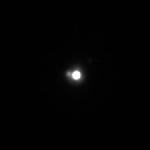Actaea (moon)
| (120347) Salacia I (Actaea) | |
|---|---|

|
|
| Actaea (left) and Salacia through the Hubble Space Telescope | |
| Provisional or systematic name | S / 2006 (120347) 1 |
| Central body | (120347) Salacia |
| Properties of the orbit | |
| Major semi-axis | 5619 ± 87 km |
| Periapsis | 5572 km |
| Apoapsis | 5666 km |
| eccentricity | 0.0084 ± 0.0076 |
| Orbit inclination | ? ° |
| Orbital time | 5.49380 ± 0.00016 d |
| Mean orbital velocity | 0.05 km / s |
| Physical Properties | |
| Albedo | |
| Apparent brightness | 1.9 (absolute) likes |
| Medium diameter | km |
| Dimensions | 1.86 x 10 19 kg |
| Medium density | (System) g / cm 3 |
| discovery | |
| Explorer |
|
| Date of discovery | July 21, 2006 |
Actaea is the only known moon of the Cubewano and dwarf planet candidate (120347) Salacia . Its mean diameter is 303 kilometers, which is about 3/4 of the parent asteroid . Therefore this system can also be understood as a double asteroid system.
Discovery and naming
Actaea was discovered in September 2006 by Keith S. Noll, Harold F. Levison, Denise C. Stephens, and William M. Grundy during observations with the Hubble Space Telescope on July 21, 2006. Both components of the system could be recognized as clearly separated by the recordings. Actaea was found at 0.110 ± 0.002 arc seconds from Salacia, with a difference in apparent magnitude of 2.3 m . The discovery was announced on September 19, 2006, almost exactly two years after the parent asteroid was discovered; the moon was given the provisional designation S / 2006 (120347) 1 .
On February 18, 2011, the moon - together with the moons of (216) Cleopatra , Cleoselene and Alexhelios - was officially named by the International Astronomical Union (IAU) after Aktaia , one of the 50 Nereids , the daughters of Nereus and Doris .
Track properties
Actaea orbits Salacia on a prograde , elliptical orbit at an average distance of around 5,619 kilometers (6.209 Salacia or 18.544 Actaea radii) to the common barycentre . This is the closest orbit of two large Kuiper Belt objects, possibly only surpassed by the much smaller Borasisi - Pabu system. The orbital eccentricity is 0.0084, the inclination is still unknown.
Actaea orbits Salacia in 5 days, 11 hours and 51.1 minutes, which corresponds to 18,184.5 orbits ("months") in one Salacia year (274.53 earth years). In this binary system, a month therefore lasts 21.65 Salacia days.
Physical Properties
Actaea has a diameter of 290 km, which corresponds to about 34.4% of the central body, which suggests a comparison with the Orcus - Vanth system. Actaea is currently the third largest asteroid moon , after Ilmarë (376 km) and Haumeas Hiʻiaka (320 km).
Due to the low system density of 1.16 g / cm 3 , Actaea as well as Salacia would have to consist primarily of water ice with additions of rock. The mass of the whole system is 4.66 ± 0.22 · 10 20 , of which about 96% is due to Salacia.
| year | Dimensions km | source |
|---|---|---|
| 2011 | 319.5 | Grundy et al. a. |
| 2012 | 292.8 | Vilenius et al. a. |
| 2012 | 303.0 ± 35.0 | Stansberry et al. a. |
| 2013 | 286.0 ± 24.0 | Fornasier et al. a. |
| 2014 | <165.0 | Thirouin et al. a. |
| 2017 | 290.0 ± 21.0 | Brown et al. a. |
| The most precise determination is marked in bold . | ||
See also
Web links
- International Astronomical Union Circular No. 8751 September 19, 2006 (Discovery)
Individual evidence
- ↑ Mike Brown: The Dwarf Planets
- ^ Johnson archives: (120347) Salacia and Actaea
- ↑ JPL Small-Body Database Browser: (120347) Salacia
- ^ W. Grundy et al .: Five New and Three Improved Mutual Orbits of Transneptunian Binaries (March 2011)
- ^ E. Lellouch et al: "TNOs are Cool": A survey of the trans-Neptunian region VI. Herschel / PACS observations and thermal modeling of 19 classical Kuiper belt objects (April 2012)
- ↑ JA Stansberry: Physical properties of trans-neptunian binaries (120347) Salacia – Actaea and (42355) Typhon – Echidna (June 2012)
- ↑ S. Fornasier include: TNOs are Cool: A survey of the trans-Neptunian region. VIII. Combined Herschel PACS and SPIRE observations of 9 bright targets at 70--500 micron (May 2013)
- ↑ A. Thirouin include: Rotational properties of the binary and non-binary populations in the Trans-Neptunian belt (July 2014)
- ↑ M. Brown et al .: The density of mid-sized Kuiper belt objects from ALMA thermal observations (February 2017)



